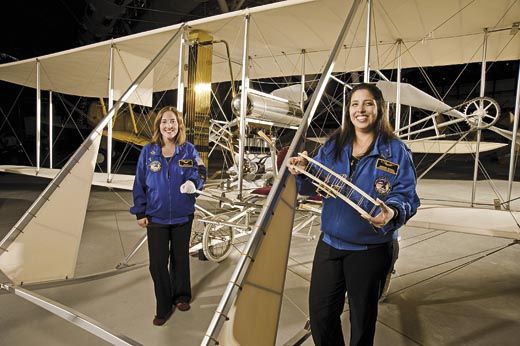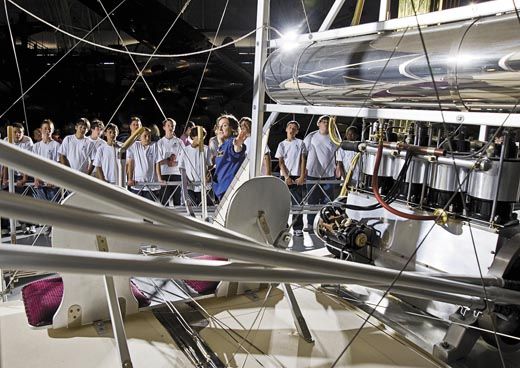In the Museum: Flight at the Museum
In the Museum: Flight at the Museum
/https://tf-cmsv2-smithsonianmag-media.s3.amazonaws.com/filer/Arch_NASM_Main_AUG09.jpg)
Kara Fahy stands in front of the classroom gazing at the seventh grade boys visiting from St. John Regional Catholic School in Frederick, Maryland. “Who knows the myth of Icarus?” she asks. “How does it go?”
A student raises his hand and recounts how young Icarus, disregarding his father’s warning about flying too near the sun, took off on wax-and-feather wings and plunged into the sea.
“So what’s the moral of the story?” asks Fahy.
The student thinks for a moment. “Don’t fly?”
It’s a typical day in the Learning Lab for Fahy and her colleague, Deborah Jackson, both aerospace educators at the National Air and Space Museum’s Steven F. Udvar-Hazy Center in Virginia.
Jackson and Fahy have 11 labs for visiting schoolchildren; this one, Forces of Flight, outlines flight’s four basic principles: weight, lift, thrust, and drag. After quickly covering the Montgolfier brothers’ 18th century experiments with hot-air balloons and the 19th century gliders of Otto Lilienthal, Fahy takes the students onto the Museum floor, where they’ll examine the Wright Model B. Because the aircraft is a reproduction, built and donated by Ken Hyde and the Wright Experience, the students are able to touch some of its parts, including its wooden propeller.
The St. John students are interested in space travel, so after returning to the lab, Fahy talks about NASA’s Constellation program, which calls for colonizing the moon and traveling to Mars.
“Let’s talk about force,” says Fahy. “How does gravity work on you? What would it be like to move around, if Earth’s gravity was twice as strong?”
“It would be like Krypton,” offers a student. “You know, the planet where Superman’s from?”
Despite their joking, the students are eager to learn. “Why does the moon have enough gravity to affect the tides of the Earth, but it can’t hold you down on the surface?” asks another student, giving Fahy the opportunity to explain how mass affects gravity in space.
Jackson and Fahy generally teach four sessions a day, with 30 students in each class; they can accommodate students ranging from kindergarten (youngsters get a 60-minute session) through 12th grade (older students are offered a 90-minute lab).
The position of aerospace educator lasts for two years; Jackson is finishing her second year and will return to Loudoun County, Virginia public schools, where she teaches special education classes. Fahy, who teaches elementary school in Fairfax County, is just beginning her second year.
In the lab, Fahy asks the students to speculate about what a change in air pressure would do to a pilot’s lungs. To demonstrate such a change, she puts a Marshmallow Peep inside a vacuum chamber. As she pumps the air out of the chamber, the Peep expands dramatically.
“It’s going to explode!” yell the students. “Can we eat it?”
“No, these are Peeps in the name of science,” says Fahy. “We can’t eat these.” As she releases air back into the chamber, the Peep shrivels, then does a wild somersault.
“OK, how’s it look?”
“Deflated,” comes the response. “Like an old person,” a student adds helpfully.
The experiment allows Fahy to talk about flightsuits and spacesuits, pressurized airplane cabins, even “the bends,” the decompression sickness divers experience.
After discussing thrust and drag, Fahy has the students select items for a survival kit, part of a test created by NASA.
“Imagine you’ve crash-landed on the moon,” says Fahy. “It’s going to take three to five days for a rescue mission to get to you. What do you need to survive in space?”
The students work in teams, quickly discarding the compass, parachute, and matches in favor of oxygen, water, and food.
As the lab winds to a close, the boys head out for a docent-led tour of the Udvar-Hazy Center. Who knows what their future holds? It’s possible that one or more of these students will become the very scientists who take us to Mars and beyond.
To learn more about the education programs offered at the Steven F. Udvar-Hazy Center, and to make reservations for a class visit, go to www.nasm.si.edu/education.

